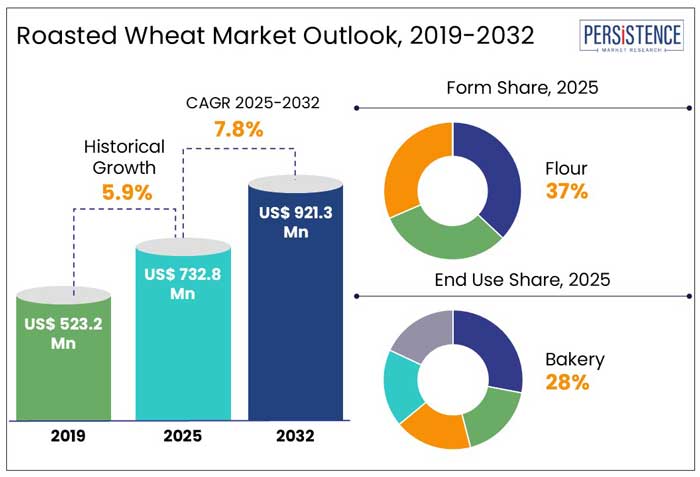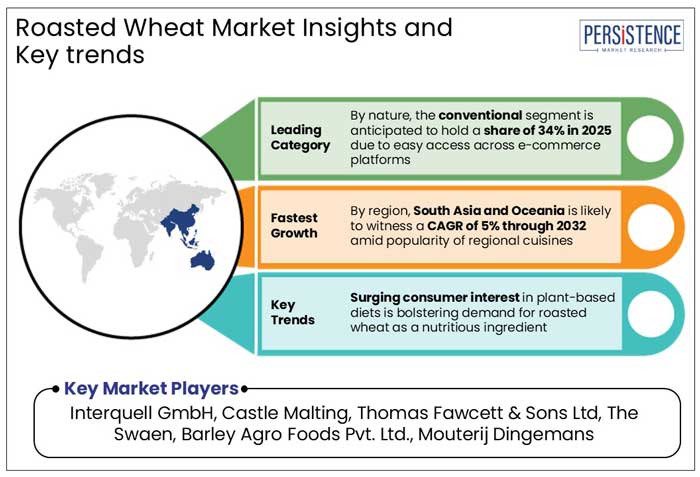Industry: Food and Beverages
Published Date: February-2025
Format: PPT*, PDF, EXCEL
Delivery Timelines: Contact Sales
Number of Pages: 182
Report ID: PMRREP31330
The global roasted wheat market is anticipated to reach US$ 732.8 Mn in 2025 and exhibit a CAGR of 7.8% from 2025 to 2032. It will likely attain a value of US$ 921.3 Mn in 2032.
The health advantages of roasted wheat are one of the main causes of its rising popularity. The large amount of dietary fiber that is retained in roasted wheat facilitates digestion and supports intestinal health.
Foods high in fiber, such as roasted wheat, are becoming immensely popular as consumers place more emphasis on consuming a balanced diet. It is also a good source of vitamin B, protein, and key minerals like iron, magnesium, and zinc, all of which support general health and well-being.
Roasted wheat retains its natural taste, making it a popular option for health-conscious individuals, in contrast to refined wheat products, which lose a large percentage of their nutrients during processing. Roasted wheat contains about 3.5 to 4.0 mg of iron, 2.5 to 3.0 mg of zinc, and 90 to 110 mg of magnesium per 100 grams, making it a nutrient-rich food option.

Key Market Highlights
|
Market Attributes |
Key Insights |
|
Roasted Wheat Market Size (2025E) |
US$ 732.8 Mn |
|
Projected Market Value (2032F) |
US$ 921.3 Mn |
|
Global Market Growth Rate (CAGR 2025 to 2032) |
7.8% |
|
Historical Market Growth Rate (CAGR 2019 to 2023) |
5.9% |
South Asia and Oceania is anticipated to generate a roasted wheat market share of 42% in 2025 and witness a CAGR of 5% through 2032. High popularity of regional culinary traditions that use roasted wheat as a main ingredient in traditional meals, such as Maharashtra's ‘bhakri,’ is augmenting demand for roasted wheat in South Asia.
Consumer preferences for roasted wheat are also being influenced by surging trend of health awareness campaigns that highlight the advantages of whole grains and natural foods. This is demonstrated by several health initiatives in countries like India that promote the consumption of healthy snack options.
Consumption of quick-to-prepare and convenient foods is also rising because of rapid urbanization and lifestyle changes in various cities across South Asia. These are augmenting demand for roasted wheat snacks like roasted wheat flour cookies and whole grain energy bars.
In terms of form, the flour segment is set to lead the roasted wheat market and hold a share of 37% in 2025. Because of its superior versatility, roasted wheat flour can be used in a variety of products, such as baked goods, snacks, and even traditional dishes from several cultures. Both home cooks and food manufacturers favor it due to its capacity to improve textures and flavors.
In terms of end use, the bakery segment is anticipated to generate a share of 28% in 2025. The process of roasting wheat gives it a rich, nutty flavor that customers find appealing. Using roasted wheat can enhance the flavor and texture of bread, pastries, and other baked goods, which is something that bakers are increasingly looking to do in a saturated market.
To appeal to a surging clientele that appreciates unique culinary experiences, several artisan bakeries, for instance, have started using roasted wheat flour in their recipes to produce distinctive flavors. A shift toward healthy eating habits has resulted from rising consumer knowledge of health and wellness, which is pushing demand for healthy baked goods. For example,
Customers are becoming more conscious of the health advantages of whole grains like toasted wheat in their plant-based diets. Plant-based diets have been linked to lower chances of chronic illnesses like obesity, diabetes, and heart disease, according to research.
Roasted wheat is a popular ingredient for people looking to improve their general health because of its high fiber, protein, and critical elements. It is also an ideal plant-based source of nourishment.

The global market for roasted wheat witnessed a CAGR of 5.9% in the historical period from 2019 to 2023. Significant changes in consumer behavior were brought about by the COVID-19 pandemic in 2020, with an increasing emphasis on wellness and health.
Several people started baking at home, which raised demand for products like toasted wheat flour. Sales of baked goods increased by 30% during the pandemic, which helped temporarily increase demand for roasted wheat as people looked for healthy baking options. For instance,
In 2022, customer tastes shifted toward gluten-free and alternative grain products, despite the rise in health awareness. General demand for roasted wheat decreased to a certain extent as a result of this factor. For example,
The global market is anticipated to witness steady growth from 2025 to 2032 backed by rising shift of millennials toward clean label products.
Shift toward Artisanal and Whole Grain Products
Modern customers are looking for products manufactured with premium ingredients and conventional techniques. Craftsmanship is emphasized in artisanal baking, which frequently employs traditional methods to improve flavor and texture.
Roasted wheat flour is increasingly being used in recipes by several artisanal bakers to add distinctive flavors and health advantages. San Francisco's Tartine Bakery, for instance, is well known for its handcrafted bread prepared with freshly ground whole grain flours, such as toasted wheat.
Surging Consumer Preference for Clean Label Products
Customers are calling for more openness about where food products come from and how they are processed. For instance,
Younger generations like millennials and Gen Z, who place a higher value on clean labeling when making purchases, are especially showcasing this demand for transparency. As these customers are actively looking for items with well-known, healthful components, firms are reformulating their current products or launching new clean label options.
Ongoing Inclination toward Alternative Grains
Due to their superior nutritional value or distinctive flavors, consumers are increasingly experimenting with different grains, including quinoa, millet, and spelt. Rising acceptance of ancient grain and gluten-free diets has contributed to this change.
The market for roasted wheat has been impacted as more people look for alternatives to conventional wheat products. For instance,
Rising Innovations in Bakeries Worldwide
Several bakeries are using roasted wheat to create distinctive flavor combinations in specialty pastries and delights that appeal to a wide range of consumers. Bakeries, for instance, are experimenting with using toasted wheat in brownies, muffins, and cookies to improve their texture and flavor while highlighting the health advantages of whole grains.
One such example is the Australia-based bakery business Baker's Delight, which has launched a line of muffins made with roasted wheat flour and promoted them as a healthier substitute for conventional pastries. Customers are searching for delights that provide nutritional advantages without sacrificing flavor, which is in line with the rising trend toward healthier options.
Unique Marketing and Educational Campaigns
Bakeries are putting more emphasis on marketing and informing customers about the advantages of whole grains in an effort to increase demand for roasted wheat. Several bakeries are showcasing the health benefits of roasted wheat, like its greater fiber content and rich flavor profile, through social media and in-store advertising.
Bakeries may extend their clientele and entice customers to explore new products by raising awareness of the health advantages of roasted wheat. The Whole Grains Council, for instance, promotes the health advantages of whole grains through campaigns, which increases customer interest in products made with roasted wheat and other ingredients.
A wide variety of companies, including well-known corporations, up-and-coming labels, and artisanal manufacturers, compete for a high share in the booming health-conscious consumer-led industry that defines the roasted wheat market. The market is dominated by key companies like Bob's Red Mill and King Arthur Baking Company, who take advantage of their well-known brands, wide range of products, and dedication to quality.
Leading businesses can reach a wide audience due to well-established distribution channels, such as retail partnerships and e-commerce platforms. Small-scale companies, on the other hand, are starting to concentrate on organic and specialty roasted wheat products that meet particular dietary requirements and tastes. Because of this fragmentation, there is fierce competition, and firms are constantly coming up with new ideas to stand out from the competitors and draw in customers.
A Few Leading Players in the Market
|
Attributes |
Details |
|
Forecast Period |
2025 to 2032 |
|
Historical Data Available for |
2019 to 2023 |
|
Market Analysis |
US$ Million for Value |
|
Key Regions Covered |
|
|
Key Market Segments Covered |
|
|
Key Companies Profiled in the Report |
|
|
Report Coverage |
|
|
Customization and Pricing |
Available upon request |
By Nature
By Form
By End Use
By Region
To know more about delivery timeline for this report Contact Sales

The market is estimated to reach US$ 732.8 Mn in 2025.
The global market will likely reach US$ 921.3 Mn in 2032.
Interquell GmbH, Castle Malting, and Thomas Fawcett & Sons Ltd are the leading brands.
The bakery segment is likely to dominate the global roasted wheat market.
South Asia and Oceania is likely to lead the global market in 2025.